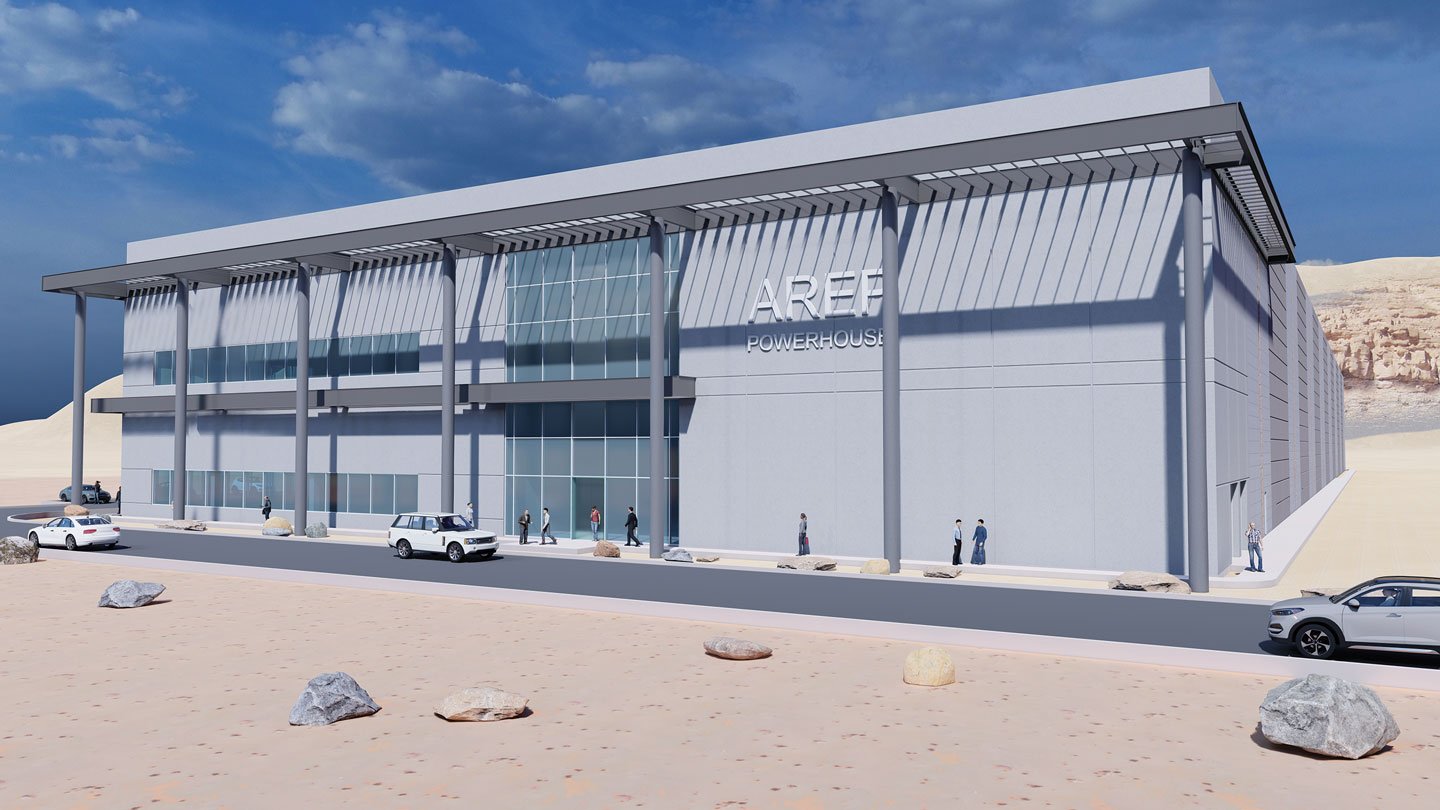
Pioneering Sustainable Design for Data Centers
Data-informed decision-making is crucial to improving the efficiency and environmental performance of data centers.
Many factors are driving the delivery and occupancy of sustainable data centers. The most obvious is the regulatory environment, which influences industry practices and requires compliance. The commercial real estate community also recognizes the need for thoughtful decision-making and more transparent reporting in an industry that produces roughly 40% of global carbon emissions.
To this end, data collection is critical to decision-making from both a cost and efficiency standpoint. Performing assessments, conducting energy modeling and pursuing third-party whole-building certification helps those who design, construct or own data centers to better understand how design decisions influence a building’s overall impact and how the building will be affected in the future.
One Company’s Approach
PowerHouse Data Centers, wholly owned and operated by American Real Estate Partners (AREP), has over 16.8 million square feet of data center facilities underway, in planning or completed for a total of 4.1 gigawatts of utility power. As AREP’s data center platform, the team works to integrate ESG strategies into every aspect of PowerHouse’s operations, setting ambitious goals for project sustainability, occupant health and wellness, and community impact. The company understands that to meet these goals, everyone must have a seat at the table to leverage appropriate resources during the early stages of schematic design.
Sustainability Champion
PowerHouse approaches each data center holistically, selecting the architect and design team (who can work to link tangible design strategies) and the general contractor simultaneously. PowerHouse designates a sustainability champion to lead the strategy, although every partner is held accountable for their impact. Another core aspect of the development process is partnership with the stakeholder community. The sustainability champion works with key individuals and organizations to address questions and identify ways to deliver value to the community. This could include partnering with local nonprofits supporting STEM education and creating opportunities for students to learn about the data center industry.
Case Study: PowerHouse Reno Campus
Reno, Nevada, is a new market for PowerHouse, which erected several facilities on the East Coast before expanding to Nevada, Texas and North Carolina. The environmental considerations in Reno are unlike those along the Eastern Seaboard. This area has a dry climate with frequent water shortages and the potential for wildfires. Given that data centers can be significant water consumers, it’s important to take water scarcity into consideration.
“As sustainable developers, we care about the impact development has on our surrounding communities and desire to be mindful of any local constraint that is unique to the area during the build process,” said Karen Petersburg, LEED AP, vice president of data center development and construction at PowerHouse.
During the early phases of design for the three-building campus, PowerHouse partnered with Bala Consulting Engineers and HKS Architecture to conduct a deep-dive assessment of Reno. The assessment utilized HKS’s Nature of Place methodology, which is grounded in the AIA Framework for Design Excellence, alongside Bala’s Climate Risk and Resiliency Assessment, which follows the standard risk profiling and resilience process. For further details, Bala’s approach aligns with guidelines available on the U.S. Climate Resilience Toolkit website (toolkit.climate.gov) under “Steps to Resilience.”
PowerHouse committed to developing a surrounding landscape that required little to no additional water. Storey County, part of the Reno-Sparks metropolitan area, requires greenscaping for new construction projects. However, the county is receptive to environmental concerns and understood that landscaping in new developments requires irrigation and that few options exist for attractive native landscaping. When PowerHouse presented a xeriscape plan consisting of rocks and boulders, Storey County accepted rock garden beds as a beautification alternative. This strategy allowed PowerHouse to use existing on-site materials excavated from the site’s mountainous terrain to reduce water consumption and minimize carbon emissions by not transporting equipment to install an irrigation system.
Another environmental concern in dry climates is the risk of wildfires. The land area burned by wildfires in the Western U.S. has nearly doubled in the past three decades. Although PowerHouse Reno is not at high risk of experiencing a wildfire itself, Bala recommended following the ASHRAE Guideline 44P planning framework in the site’s design to prevent smoke infiltration into the building.
Data on current and future climatic events was evaluated to understand the impact on the project site, including assessing potential hazards and risks in terms of probability and severity. Bala identified and prioritized key risks for each hazard specific to the site, including high winds, wildfires, extreme heat and seismic/soil stability. While the project is still in the design phase, these risks are being evaluated to ensure resiliency is integrated into the final design. Specific details on how these factors will be addressed will become available as the design progresses.
In addition, a computational fluid dynamics analysis, including a wind rose study, was conducted to inform building orientation. This analysis considered both current and future wind patterns, ensuring that the project’s orientation is strategically set up for long-term success. Each assessment provided critical information to help PowerHouse make informed design decisions.
“The up-front design analysis is a fraction of a fraction of the entire build cost, and when done correctly, it increases the profitability of the project, as focus is always on four core pillars during major decisions: scope, schedule, budget and sustainability,” Petersburg said.
Improving Environmental Performance
To ensure transparency and accountability, Bala created a sustainability index that it introduced to integrated project teams during the kickoff meeting. The Bala Sustainability Index includes the most important metrics around sustainability, with questions specific to operational and embodied carbon, energy usage intensity, power usage efficiency, and water and waste reduction strategies. It also includes easier to manage aspects such as lighting power density. This evaluation matrix is reviewed and updated throughout the construction process and submitted with every substantial design deliverable.
Bala also conducted a whole-building life-cycle assessment (WBLCA) on the data center’s building materials and systems throughout the design. WBLCAs determine the environmental impact of a building project by evaluating the carbon emissions from raw material extraction through construction, operation and end of life. This data provides opportunities to reduce operational and embodied carbon by making deliberate design decisions regarding building materials and systems and sourcing locally when possible.
Bala identified low-global-warming-potential concrete targets, which will be included in design specifications (using the 2021 Carbon Leadership Forum material baselines). HITT, the general contractor, is including carbon/environmental product declaration language in its subcontractor language so that Bala can accurately estimate the project’s embodied carbon.
Designing a building or portfolio without regard for the envelope can negatively affect energy consumption for years to come. Long-term efficiency and cost consequences can be substantial if the design is not analyzed during the early stages. Strategizing early allows for future operational savings for both costs and emissions.
Once the PowerHouse Reno campus building was preliminarily designed, HKS performed a series of energy models. By running these scenarios, HKS determined the impact of efficiency strategies, material selections and areas for improvement. PowerHouse is benchmarking overall energy consumption against the ASHRAE 90.1-2019 standard. The energy model demonstrated a 50% reduction in lighting and 30% reduction in space cooling, reducing the total building energy by 2.7%, meeting jurisdictional ASHRAE code requirements. Energy models provide key data on how materials affect a building’s envelope design. This data can then be demonstrated for credit compliance within the Green Building Initiative’s (GBI) third-party assessment and certification programs.
Green Design Strategies
Together with HKS Architecture and Bala Consulting Engineers, PowerHouse is pursuing both GBI’s Green Globes and Journey to Net Zero certifications for the Reno campus. The team has benefited from implementing the design strategies recommended throughout the Green Globes process, including:
- Reusing boulders on-site rather than planting trees.
- Starting conversations with a local utility about procuring renewable power and carbon offsets.
- Using the Green Globes Water Calculator to reduce water usage inside the building where possible.
- Setting specific waste diversion goals and collecting environmental product declarations during the construction phase with HITT.
The pursuit of assessment and eventual achievement of third-party certification recognizes PowerHouse and its partner team’s ability to develop, design and deliver sustainable, healthy and resilient data centers that contribute positively to the local community. PowerHouse hopes its expertise and commitment to sustainability will provide the playbook for the industry, particularly during a time of unprecedented growth for data centers.
Learn More about PowerHouse Reno by visiting powerhousedata.com/data-center/powerhouse-reno.
Megan Baker is vice president of engagement at the Green Building Initiative.
PowerHouse Reno Details and SpecificationsAcreage: 49 acres |
GBI Certification ProgramsGreen Globes is a science- and consensus-based certification program that evaluates the sustainability, health and wellness, and resilience of commercial and multifamily real estate. The program serves as an educational framework; the criteria and a third-party Green Globes Assessor guide design and operational practices to deliver a more sustainable building or portfolio. Criteria are evaluated based on environmental impact and distributed across six key assessment areas: project management (new construction) or ESG management (existing buildings), site, energy, water efficiency, materials, and indoor environment, with a total of 1,000 maximum points. Green Globes provides a flexible framework, ensuring a rigorous yet adaptable approach to environmental assessment. GBI’s Green Globes Journey to Net Zero assessment and certification program advances decarbonization in the built environment by empowering commercial real estate owners to evaluate performance using a science-based approach to implement impactful change. GBI uses its Net Zero Calculator to determine a percent energy or carbon reduction from a baseline for an individual building or an entire portfolio. |





